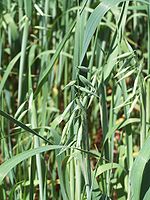
Photo from wikipedia
Frost, drought and heat are key abiotic constraints to barley production in Australia. To maximise grain yield, crop life-cycle needs to be timed to minimise growth stresses associated with insufficient… Click to show full abstract
Frost, drought and heat are key abiotic constraints to barley production in Australia. To maximise grain yield, crop life-cycle needs to be timed to minimise growth stresses associated with insufficient radiation, frost, heat and drought stress during the critical period for yield determination that occurs prior to and during flowering. To identify optimal flowering times for commercial Australian barley genotypes, we conducted a genotype (G) × environment (E) × management (M) analysis using climate data from locations distributed throughout the Australian barley growing regions. Prior to conducting the G×E×M, we parameterised key phenological variables in the APSIM-Barley module for all genotypes using photoperiod and vernalisation data from experimental treatments, then we verified the model using seven independent field experiments. The verification process showed an average RMSE of 1.4–7.2 days and R2 values of 0.83–1.00 depending on genotype, indicating reasonable performance of the model in simulating phenology. Using the parameterised model, we then characterised water, frost and heat stress patterns for a range of sowing date × genotype combinations. The G×E×M showed that optimal flowering period (OFP) was a function of the environment more so than the genotype, and the relative importance of insufficient radiation, frost, heat and water stress varied signficantly with location. OFP was earlier (mid August to late September), in Western Australia and South Australia, while OFP was later (mid-October to mid-November) in Tasmania and Victoria. In low rainfall environments, the duration of the OFP was shorter in most cases than in high rainfall environments. In general, earlier sowing (1 April to 22 April) resulted in lower yield across sites, and this was more pronounced for fast developing genotypes La Trobe, Fathom, Compass and Alestar. Later sowing (1 June to 30 June) at Condobolin (NSW), Hopetoun (WA) and Loxton (SA) also resulted in a lower yield for all genotypes. Knowledge of OFPs based on long-term abiotic stresses will allow breeders to develop genotypes with phenological durations that are pertinent to each location. This will also allow farmers to select sowing dates according to genotype duration and thus minimise the combined risk of frost, heat and water stresses, which collectively should allow yield to approach its maximum potential.
Journal Title: Agricultural and Forest Meteorology
Year Published: 2020
Link to full text (if available)
Share on Social Media: Sign Up to like & get
recommendations!